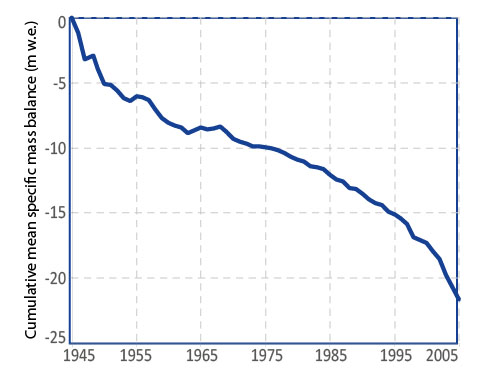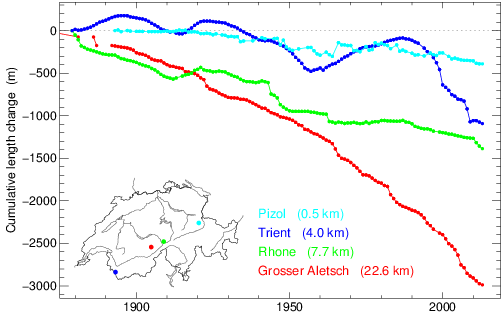 |
|
|
|
|
|
|
Glaciers directly respond to changes in climate through changes in their mass balance. Since the end of the Little Ice Age in the mid 19th century, glaciers all over the world have been receding dramatically, with accelerating rates since about 1985 (fig. 1). For the Alps, total ice volumes in 1850, the 1970s and 2000 are estimated to be about 200 km3, 100 km3 and 75 km3, respectively. In the extraordinarily warm year of 2003 additional 5-10 per cent of the remaining ice volume were lost (table 1).
|

1 - Cummulative global mean specific mass balance
|
|||||||||||||||||
While changes in mass balance also affect the area covered by a glacier this relationship is also dependent on ice thickness, altitude and steepness of the terrain, resulting in large differences between single glaciers. Overall, Alpine glaciers had lost about 50% of their 1850 area by the year 2000 (fig. 2). Given the present climate scenarios, glacier recession will continue and may lead to deglaciation of many mountain regions by the end of the 21st century. This will affect landscape appearance and have large implications on seasonal freshwater availability. In addition, there is an increased risk of natural hazards. For example, existing glacier lakes have partly increased and new lakes have formed at a rapid rate during the last decades, especially in the tropical Andes and Himalayas, increasing the risk of outburst floods. |

2 - Glacier front variations in the European Alps. Large Alpine glaciers have retreated continuously since the mid 19th century, whereas steep mid-sized glaciers reacted with re-advances in the 1890s, 1920s and between the 1970s and1980s due to somewhat cooler and wetter periods. Small glaciers feature a high annual variability, but with a clear shrinking trend. |
|||||||||||||||||
|
|
|
Another but less eye-catching consequence of climatic warming is the thaw of permafrost. Permafrost responds to atmospheric temperature increase, but other factors like soil properties and water content and snow also have a large influence. Borehole measurements during the last decades showed a warming trend of permafrost and a thickening of the active layer. The response to atmospheric warming takes place at different scales of time and depth. Localities at the lower permafrost limit are especially sensitive to changes, and respond with a short time lag (in the order of days to months). In the Alps, the frequency of rock falls has increased during the last decades. In particular, the extreme summer of 2003 was associated with greatly increased rock fall activity within the permafrost zone.Large-scale responses to warming permafrost, such as the development of deep-seated slope instabilities, may show a delay of decades or centuries. Thus, the probability of large-scale rock falls (millions of cubic meters and more) is likely to increase with time in a period of climate warming.
|
|
||||
13 August 2018 |
||
| |
||